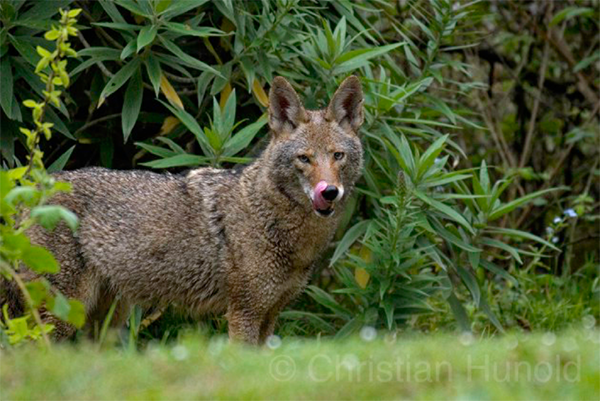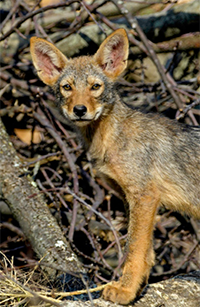There Goes the Neighborhood: Urban Coyotes in Pennsylvania and California
September 24, 2018
By Christian Hunold, PhD, associate professor of politics, and Teresa Lloro-Bidart, PhD, Cal Poly Pomona

Coyote in Golden Gate Park, San Francisco © Christian Hunold
Coyotes have incorporated themselves into nearly every major city in North America. Coyotes’ ability to thrive in cities testifies not only to the Anthropocene’s blurring of human-wildlife boundaries; it also undermines the idea that cities and suburbs are places where people don’t have to contend with wild predators. In cities where coyotes have become established recently, their arrival has coincided with a reevaluation of urban ecologies and of the role of wild animals in urban settings. Conservation scientists are deemphasizing conflict management in favor of peaceful coexistence. And human-animal studies scholars are generating multispecies accounts of city life that seek to take seriously wild animals as social actors, both in how they interact with humans and in their own right. Our study of how residents of two cities – Philadelphia, PA and Chino/Chino Hills, CA – attempt to make sense of urban coyotes asks how such calls for more inclusive human-wildlife relations resonate in popular imaginaries of urban life.
MULTISPECIES ETHNOGRAPHY: ENCOUNTERS WITH URBAN COYOTES
In Philadelphia and in Chino/Chino Hills, humans and coyotes occasionally meet one another in their travels around the city. But such encounters are often fleeting and may not reveal very much about the mostly hidden world of urban coyotes. The intensively relational methodologies that inform multispecies ethnographies of dog trainers and their dogs, equestrians and their horses, and similarly close-knit interspecies relationships seem misplaced here. How, then, are we to think about human-coyote relationships in these two cities? Much of what people know and feel about coyotes does not arise from meaningful relationships with actual coyotes but from mediated representations. Urban coyotes, for their part, are intelligent observers of human behavior and adroitly time their movements around human schedules. If, following Candea, human-animal relationships range across a spectrum, with a complete lack of connection at one end and genuine intersubjectivity at the other, then coyotes, perhaps, are not unlike that quiet family next door who prefer to keep mostly to themselves – except, of course, that coyotes aren’t exactly quiet:
HUMAN-COYOTE CULTURES: RENEGOTIATING URBAN/WILD BOUNDARIES
Our study of popular understandings of urban coyotes analyzes relevant discussions in Facebook neighborhood community pages that took place in 2016 and 2017. Here we want to discuss some of our findings regarding participants’ perceptions of the legitimacy of coyotes’ presence in urban areas as well as their feelings about the blurring of human-wildlife boundaries.
In Philadelphia, residents who welcomed urban coyotes articulate two distinctive themes. One is ecological. Apex predators are “good for the environment” because they help keep (unwanted) rodent and deer populations in check; coyotes are described as “nature’s way to put things back in balance.” This line of thinking doesn’t explicitly connect apex predators and increased biodiversity in the formal sense of a trophic cascade; rather, participants express a feeling that things must be going well if coyotes are moving into the neighborhood. The second theme is one of enjoying the sense of wildness instilled by the possibility of encountering coyotes next door: “Saw a couple in Wissahickon Park a few years ago. Great experience.” Like-minded posters describe coyotes as fascinating, smart, beautiful, resilient, and cool, and urban settings as places where people and wildlife can coexist; indeed, the presence of wildlife, including coyotes, is taken as a sign that the neighborhood is a good place to live because wild animals live there too. For these residents, the city is not just for people.

Residents uneasy about coyotes’ presence express discomfort at rubbing shoulders with an unfamiliar and sizable wild predator. An interesting twist relates to the Eastern Coyote’s past hybridization with Gray Wolves, which has produced a wild canine that is physically more robust than Western Coyotes. For residents who dislike their new neighbors, framing these animals as “coywolves” signals not adaptive evolution – a “bigger coyote” capable of taking down White-tailed Deer – but a sense of disquiet about this strange new species of dubious origin and with uncertain claims to permanent residency in Pennsylvania.
In Southern California, these questions of belonging play out a little differently. The cities of Chino and Chino Hills, located about 35 miles east of Los Angeles in the relatively arid valley of the San Bernardino Mountains, are home to a growing number of urban coyote populations. Residents in Chino Hills, bordering on thousands of acres of undeveloped lands, appear to be more accustomed to living with coyotes than residents in Chino, who have only recently had to grapple with their more significant presence. Unlike its southernmost neighboring city, Chino Hills, Chino is surrounded on all sides by suburban and urban development. There is, therefore, less of an expectation that one would encounter a predator like coyotes, who tend to stick closer to parks or undisturbed places. Although people in Chino and Chino Hills generally don’t appear to be excited about living with coyotes, they recognize their presence there as legitimate. Here, legitimacy is tightly bound to place-based understandings of rights to land where humans and nonhumans alike can leverage legitimate claims. Time and again, residents proclaimed that coyotes have (1) a right to be here because this was their land first and (2) coyotes have pushed north into Chino only because of rampant development. For example, a post about a coyote killing someone’s pet in Chino Hills ignited nearly 100 comments, “[We] are destroying our Hills to build over-priced homes and apartments. So coyotes are moving inward.” So, in Chino Hills it is understood that the removal of open space within and around the developed sections of the suburbs is pushing coyotes further into the urban core.
In Chino, residents understand that coyotes properly “belong” in Chino Hills and have traversed into Chino only because of increased development. Although they “belong” in Chino Hills, Chino residents appear generally accepting of coyotes’ presence in their community, with the exception of a few posters who shoot at them with pellet guns. That is, coyotes have legitimate claims to urban land in Chino because they’ve lost their homelands in Chino Hills due to “greedy developers.” So, while coyotes are understood to belong to “natural spaces” out there somewhere, residents generally recognize that these undeveloped spaces are quite literally being paved over.
CITIES FOR COYOTES?
The displacement of coyotes by development is a topic of discussion in Philadelphia as well. For some residents of the neighborhood of Roxborough, coyotes have been part of the neighborhood for decades. Others, however, confess to having no inkling of their presence: “How does a coyote end up in Roxborough?!?” This question prompted a wide-ranging exchange discussing reasons why this might be so, including increased development in neighborhoods adjacent to woodlands, leading to more frequent human-coyote encounters in the residential areas of Roxborough. However, many participants viewed natural areas (woods and meadows for wildlife) and residential areas (yards for people and pets) as distinct and separate, materially and symbolically, with the imagined boundaries between the two landscapes being crossed by coyotes. Some speculated that coyotes don’t undertake such boundary crossings entirely voluntarily: development-related habitat loss was understood to be pushing the animals into residential areas in search of food. That urban coyote territories might routinely comprise sections of both undeveloped land and residential areas was not discussed. Dualist conceptions of urban nature persist here even though coyotes themselves are demonstrably unimpressed by habitat boundaries as imagined by their human neighbors. The gap between the sort of habitat people imagine coyotes prefer (undeveloped land) and the sort of habitat coyotes actually inhabit (tree-lined neighborhoods) makes it difficult for some residents to accept that they truly share their neighborhood with wild predators, who use many of the same spaces people do.
Although coyotes in the Chino/Chino Hills area materially defy urban/wild divides by thriving in residential neighborhoods, ontologically these boundaries remain rather fixed because residents understand this material boundary–crossing as unnatural. That is, drawing on Haraway, human-coyote hybrid spaces are themselves understood as unnatural occurrences brought on by nature (coyotes) being forced into unnatural relations with culture (humans and even their pets), as the following comment demonstrates, “They are going to cover all of CA in asphalt and concrete. Displace all of the wildlife. If only they could have left some land for them, they would avoid us.” So, it is still believed that coyotes should have their own land so that they will leave people (and their dogs and cats) alone. If we consider how cities might be politically and ethically inclusive spaces for people and for wild animals, coyotes do push urban/wild boundaries to now include apex predators. But those boundaries are not completely dissolved. That is, as coyotes materially cross into and thrive in cities, some ontological borders remain fixed insofar as residents are willing to live among them, but still believe their presence is unnatural.
That said, we have found less hostility toward coyotes than might be expected, given their apex predator status. For the most part, residents in Philadelphia and in Chino/Chino Hills don’t blame coyotes for moving into their neighborhoods. People may not want to follow some urban coyote advocates in imagining cities as twenty-first-century coyote preserves, but many residents tolerate, even value the presence of wildlife next door. So, do politically and ethically inclusive multispecies accounts of cities as spaces for people and for wild animals resonate with popular audiences? Up to a point. Coyotes are materially crossing into and thriving in cities, but ontological boundaries are not necessarily being erased. That is, people still sort of think they don’t belong here, though they are willing to let them live among us, for the most part. A commitment to a more fully egalitarian interspecies inclusivity, though, would involve a more complete ontological shift, whereby people see cities as being for coyotes, as well as for themselves.









No comments:
Post a Comment